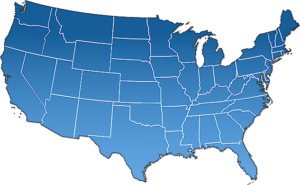 The year began with a bang but may end with a whimper.
The year began with a bang but may end with a whimper.
Legislation that would fundamentally alter public notice laws has been introduced in 21 states in 2017, and several of those bills once had real momentum. But with Memorial Day now behind us, 36 state legislatures have already adjourned and not a single one of those formerly worrisome bills is close to passage.
The latest threat to subside was in Missouri, where newspapers had been nervous about two separate bills that were reported out of committee. One would have moved municipal notices to government websites and the other threatened to shift foreclosure notices to websites operated by law firms. The clock ran out on both bills when the legislature adjourned in mid-May.
Maine’s Governor Vetoes Another Public Notice Bill
 As we noted last month, Maine Gov. Paul LePage doesn’t like the newspapers in his state. There’s now evidence to suggest his disgust for print-based local journalism provokes him to stake out irrational positions on public notice bills.
As we noted last month, Maine Gov. Paul LePage doesn’t like the newspapers in his state. There’s now evidence to suggest his disgust for print-based local journalism provokes him to stake out irrational positions on public notice bills.
In April, LePage vetoed a bill requiring newspapers to continue posting public notices on their own websites at no extra cost to the state. The veto was counterintuitive but it had an internal logic. LePage doesn’t believe in half measures. He is convinced that newspapers are dying but he’s an impatient man, so he wants to do all he can to hasten their demise.
Public Notice from a Bureaucrat’s Perspective
 The Anne Arundel (Maryland) County Council is considering legislation proposed by its Department of Public Works that would allow public notice for right-of-way purchases, road abandonment, and petitions to extend water and sewer services, to be published on its website. The bill would also eliminate the current requirement that department officials post a sign on the affected property or publish two notices in a local newspaper.
The Anne Arundel (Maryland) County Council is considering legislation proposed by its Department of Public Works that would allow public notice for right-of-way purchases, road abandonment, and petitions to extend water and sewer services, to be published on its website. The bill would also eliminate the current requirement that department officials post a sign on the affected property or publish two notices in a local newspaper.
This is a minor local issue that normally wouldn’t merit the attention of a national audience.
But a statement made by the county’s public works director to the Capital Gazette caught our attention. It perfectly encapsulates the bureaucratic perspective on public notice.
Another Governor Takes Aim at Public Notice
 We have found a governor whose animus for newspapers may exceed Chris Christie’s.
We have found a governor whose animus for newspapers may exceed Chris Christie’s.
Maine Gov. Paul LePage (photo on left) dislikes the papers in his state so intensely he vetoed a bill last month requiring them to continue to post public notices on their own websites at no extra charge to the state. Overwhelming majorities in the legislature overrode his veto the following week.
NC County Gets Great Return on Delinquent Tax Notice
 Nobody reads the paper anymore?
Nobody reads the paper anymore?
Tell that to Moore County Tax Administrator Gary Briggs, whose office recently collected 60 percent of the $1.37 million it was owed by delinquent taxpayers after publishing their names in the local newspaper, The Pilot.
Briggs published the list on March 8 as a 12-page special section in The Pilot, at a cost of $8,000. A month later his office had collected almost $821,000 of its outstanding tax debt, according to The Pilot.
Nevada the Latest Public Notice Trouble Spot
 Legislation that would authorize radio and television station websites to publish public notices in Nevada has become a serious threat to newspapers in the state, according to the Nevada Press Association (NPA). Senate Bill 218 would establish broadcaster websites as an alternative to newspapers for all legislatively mandated notices in the state, including foreclosure and other private-party notices.
Legislation that would authorize radio and television station websites to publish public notices in Nevada has become a serious threat to newspapers in the state, according to the Nevada Press Association (NPA). Senate Bill 218 would establish broadcaster websites as an alternative to newspapers for all legislatively mandated notices in the state, including foreclosure and other private-party notices.
Letter: Public Notice Might as Well Have Been in Swahili
The following is a letter to the editor of the Longmont (Colo.) Times-Call published on the newspaper’s website on March 9.
To the Editor:
What is public notice 02-2017-14 published on March 3, 2017, about? Vacation? What is a PUD? Where is Blue Vista? How can anyone be expected to make comments or decisions based on a map that is printed so small that it is unreadable — it could have been in Swahili for all it is worth.
NY Development Directors Recommend Publishing Notice in Multiple Newspapers
 At its March 23 meeting, the Empire State Development Board of Directors was discussing a Staten Island development project when the issue of public notice arose. The board had satisfied its statutory obligation by posting notice of the project in the New York Daily News, but had received complaints that notice should also have been published in the Staten Island Advance.
At its March 23 meeting, the Empire State Development Board of Directors was discussing a Staten Island development project when the issue of public notice arose. The board had satisfied its statutory obligation by posting notice of the project in the New York Daily News, but had received complaints that notice should also have been published in the Staten Island Advance.
During a brief discussion of the matter, Director Robert Dyson (on far right in photo) encouraged the Board to exceed the legislative mandate by publishing notices of its projects in multiple newspapers. “We should endeavor to make sure we never hear … that people didn’t get enough notice,” said Dyson, who later added, “It’s not a costly thing” to run public notices in newspapers.
South Dakotan Produces News Series From Public Notices
 Public notice isn’t a big deal to the nine South Dakota lawmakers who introduced House Bill 1167, a piece of legislation that would have moved municipal notices from newspapers to websites in many S.D. cities, if it hadn’t been killed in committee. To Brian Hunhoff (photo on left), public notice is absolutely vital.
Public notice isn’t a big deal to the nine South Dakota lawmakers who introduced House Bill 1167, a piece of legislation that would have moved municipal notices from newspapers to websites in many S.D. cities, if it hadn’t been killed in committee. To Brian Hunhoff (photo on left), public notice is absolutely vital.
Hunhoff, a contributing editor at the Yankton County Observer, has been demonstrating just how important it is with “In a Minutes Notice,” a new weekly column based on news culled from meeting minutes and legal notices published in the Observer and other newspapers in the Mount Rushmore state.
“I’ve been meaning to do this series for a long time, but could never seem to find the time,” says Hunhoff. “Then I read the (PNRC) story in the National Newspaper Association’s PubAux about all the public notice battles taking place around the country and decided it would be a good year to finally make time and get it done.”
Hunhoff has already published eight public notice-based columns (see PDFs linked below) and plans to write at least six more in the coming weeks. They include deep dives on particular subjects, like the salaries of local public officials or the frequency and length of their executive sessions. He has also reviewed meeting minutes and budgets from 12 similar-size cities and counties to learn how Yankton County and City of Yankton rank in comparison.
Hunhoff admits the project has required a great deal of research. He has spent many hours studying public notices in Observer bound volumes going back 40 years to uncover trends relating to tax-exempt properties, delinquent taxpayer lists, and highway department spending.
His commitment to the project is particularly remarkable when one considers that newspapering is no longer Hunhoff’s primary job. He was in the newspaper business full-time for 23 years until he sold the Observer in 2002. Current publishers are twin sisters Kathy Church and Kristy Wyland.
Hunhoff has been a part-time contributor to the 40-year-old weekly since selling it. His full-time job now is Yankton County Register of Deeds, where he takes pride in operating the best document archive — he calls it a “library” — in the state. He saves his public notice reporting for evenings and weekends.
Hunhoff says research for the public notice column inspires ideas for editorials. He has written four related opinion pieces for the paper since the first “In a Minutes Notice” story was published in mid-February.
His real goal, though, is to highlight the value of public notices in newspapers and help Observer readers understand their importance. He knows fewer people would read them if they were moved to the Internet — “out of sight, out of mind” he says — and that concerns him.
Hunhoff has used photos of local officials, town halls, a snowplow and a fire truck to illustrate the articles. Over 90 percent of the content is distilled from public notices. “It’s not a lot of fancy writing – just a straightforward presentation of facts gleaned from minutes and other notices,” he said. “I study numbers in a particular area until I find a newsworthy trend. Giving these stories a lead with a news hook has been the key to pulling readers in.”
“Reader response to the stories has been very good,” he added. “People seem to find them interesting and that’s the goal: To help folks understand how much important information is available in public notices in newspapers.”
Wisconsin, Missouri on High Alert as Public Notice Bills Churn Through State Legislatures
 More than 120 public notice bills have been introduced in at least 37 different states through the first week of March, raising varying levels of concern among newspaper publishers and state press associations around the country. The only states where the danger signs are flashing red, however, appear to be Wisconsin and Missouri.
More than 120 public notice bills have been introduced in at least 37 different states through the first week of March, raising varying levels of concern among newspaper publishers and state press associations around the country. The only states where the danger signs are flashing red, however, appear to be Wisconsin and Missouri.
South Dakota Reporter Wins Public Notice Journalism Award
 Amanda Fanger, a reporter for Reporter & Farmer, a weekly newspaper in rural Day County, South Dakota, today was named winner of the 2017 Public Notice Journalism Award. Fanger won for a story that scratched below the surface of a public notice (PDF) to reveal a potential embezzlement scheme in one of the small towns within her paper’s coverage area.
Amanda Fanger, a reporter for Reporter & Farmer, a weekly newspaper in rural Day County, South Dakota, today was named winner of the 2017 Public Notice Journalism Award. Fanger won for a story that scratched below the surface of a public notice (PDF) to reveal a potential embezzlement scheme in one of the small towns within her paper’s coverage area.
Fanger will receive a $500 award and a free trip to Washington, D.C., where she will be honored at a March 16 dinner at the National Press Club.

